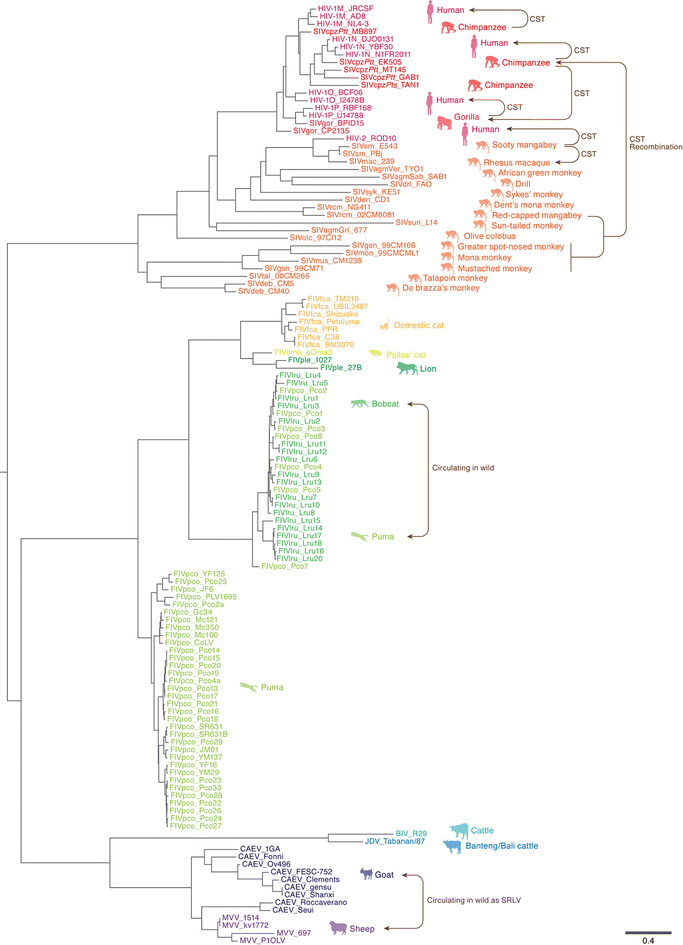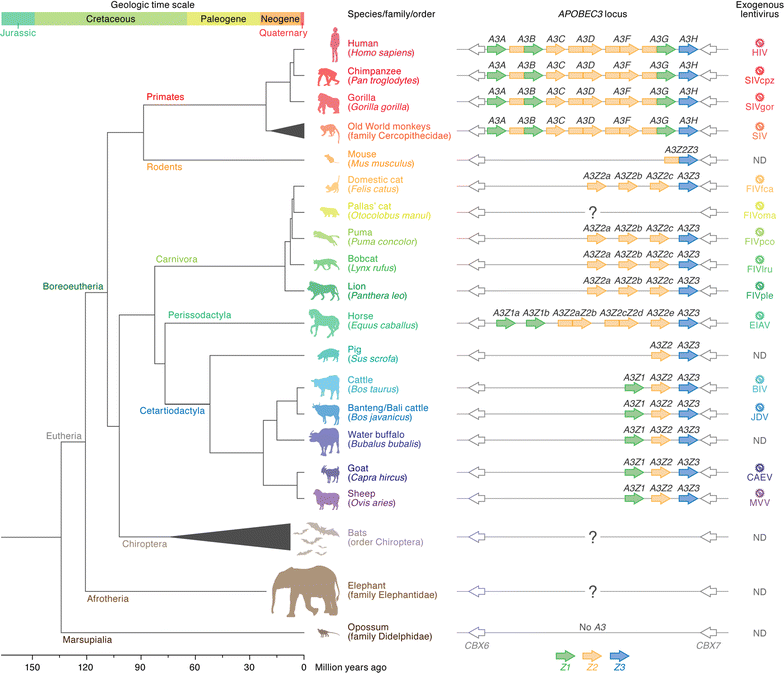A conflict of interest: the evolutionary arms race between mammalian APOBEC3 and lentiviral Vif
- PMID: 28482907
- PMCID: PMC5422959
- DOI: 10.1186/s12977-017-0355-4
A conflict of interest: the evolutionary arms race between mammalian APOBEC3 and lentiviral Vif
Abstract
Apolipoprotein B mRNA editing enzyme catalytic polypeptide-like 3 (APOBEC3) proteins are mammalian-specific cellular deaminases and have a robust ability to restrain lentivirus replication. To antagonize APOBEC3-mediated antiviral action, lentiviruses have acquired viral infectivity factor (Vif) as an accessory gene. Mammalian APOBEC3 proteins inhibit lentiviral replication by enzymatically inserting G-to-A hypermutations in the viral genome, whereas lentiviral Vif proteins degrade host APOBEC3 via the ubiquitin/proteasome-dependent pathway. Recent investigations provide evidence that lentiviral vif genes evolved to combat mammalian APOBEC3 proteins. In corollary, mammalian APOBEC3 genes are under Darwinian selective pressure to escape from antagonism by Vif. Based on these observations, it is widely accepted that lentiviral Vif and mammalian APOBEC3 have co-evolved and this concept is called an "evolutionary arms race." This review provides a comprehensive summary of current knowledge with respect to the evolutionary dynamics occurring at this pivotal host-virus interface.
Keywords: APOBEC3; Evolutionary arms race; Lentivirus; Mammal; Vif.
Figures



Similar articles
-
New World feline APOBEC3 potently controls inter-genus lentiviral transmission.Retrovirology. 2018 Apr 10;15(1):31. doi: 10.1186/s12977-018-0414-5. Retrovirology. 2018. PMID: 29636069 Free PMC article.
-
A Naturally Occurring Domestic Cat APOBEC3 Variant Confers Resistance to Feline Immunodeficiency Virus Infection.J Virol. 2015 Oct 21;90(1):474-85. doi: 10.1128/JVI.02612-15. Print 2016 Jan 1. J Virol. 2015. PMID: 26491161 Free PMC article.
-
Small ruminant lentiviral Vif proteins commonly utilize cyclophilin A, an evolutionarily and structurally conserved protein, to degrade ovine and caprine APOBEC3 proteins.Microbiol Immunol. 2016 Jun;60(6):427-36. doi: 10.1111/1348-0421.12387. Microbiol Immunol. 2016. PMID: 27193350
-
Running loose or getting lost: how HIV-1 counters and capitalizes on APOBEC3-induced mutagenesis through its Vif protein.Viruses. 2012 Nov 14;4(11):3132-61. doi: 10.3390/v4113132. Viruses. 2012. PMID: 23202519 Free PMC article. Review.
-
Host restriction of HIV-1 by APOBEC3 and viral evasion through Vif.Curr Top Microbiol Immunol. 2009;339:1-25. doi: 10.1007/978-3-642-02175-6_1. Curr Top Microbiol Immunol. 2009. PMID: 20012521 Review.
Cited by
-
Elucidation of the Complicated Scenario of Primate APOBEC3 Gene Evolution.J Virol. 2021 May 24;95(12):e00144-21. doi: 10.1128/JVI.00144-21. Print 2021 May 24. J Virol. 2021. PMID: 33789992 Free PMC article.
-
A role for gorilla APOBEC3G in shaping lentivirus evolution including transmission to humans.PLoS Pathog. 2020 Sep 10;16(9):e1008812. doi: 10.1371/journal.ppat.1008812. eCollection 2020 Sep. PLoS Pathog. 2020. PMID: 32913367 Free PMC article.
-
Genetic analysis of the pX region of bovine leukemia virus genotype 1 in Holstein Friesian cattle with different stages of infection.Arch Virol. 2022 Jan;167(1):45-56. doi: 10.1007/s00705-021-05252-2. Epub 2021 Oct 14. Arch Virol. 2022. PMID: 34651240
-
The Battle between Retroviruses and APOBEC3 Genes: Its Past and Present.Viruses. 2021 Jan 17;13(1):124. doi: 10.3390/v13010124. Viruses. 2021. PMID: 33477360 Free PMC article. Review.
-
An Alu Element Insertion in Intron 1 Results in Aberrant Alternative Splicing of APOBEC3G Pre-mRNA in Northern Pig-Tailed Macaques (Macaca leonina) That May Reduce APOBEC3G-Mediated Hypermutation Pressure on HIV-1.J Virol. 2020 Jan 31;94(4):e01722-19. doi: 10.1128/JVI.01722-19. Print 2020 Jan 31. J Virol. 2020. PMID: 31776266 Free PMC article.
References
-
- Evans DT, Elder JH, Desrosiers RC. Nonhuman lentiviruses. In: Knipe DM, Howley PM, editors. Fields virology, vol. 2. 6. Philadelphia: Lippincott Williams & Wilkins; 2013. pp. 1584–1612.
-
- Freed EO, Martin MA. Human immunodeficiency viruses: replication. In: Knipe DM, Howley PM, editors. Fields virology, vol. 2. 6. Philadelphia: Lippincott Williams & Wilkins; 2013. pp. 1502–1560.
Publication types
MeSH terms
Substances
LinkOut - more resources
Full Text Sources
Other Literature Sources

